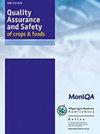Correlation between the bacterial community and flavour of fermented fish
IF 5.3
3区 农林科学
Q1 FOOD SCIENCE & TECHNOLOGY
引用次数: 7
Abstract
Common carp is a fish species of economic importance in China; traditionally it is mostly salt-fermented. In the fermenting process, the bacterial community of spontaneously fermented fish is important for its flavour and quality. However, very few studies have been conducted about the relationship between bacterial community and development of flavour involved in the salt-fermentation of carp. Therefore, we explored this relationship by determining the flavour components, including amino acids, and changes in volatile flavour and bacterial metabolite. Samples were taken during fermentation on the days 0, 10, 20, 30, 40 and 50. The second-generation 16S recom-binant DNA (rDNA) sequencing was performed to analyze the composition of bacteria. Contents of amino acids were determined by reverse-phase high-performance liquid chromatography combined with ultraviolet detection. The volatile components were analyzed with solid-phase microextraction–gas chromatography-mass spectrometry. Enterococcus, Lactobacillus, Lactococcus, Leuconostoc, and Staphylococcus were the dominant bacteria. The bidirectional orthogonal partial least squares approach was used to analyze the correlation between bacterial succession and flavour component dynamics. This study would help to better understand the role of bacteria in the fermented fish meat flavour and support the industrial production of fermented fish.发酵鱼的细菌群落与风味的关系
鲤鱼是中国一种具有重要经济价值的鱼类;传统上,它主要是盐发酵的。在发酵过程中,自发发酵鱼的细菌群落对其风味和品质至关重要。然而,关于鲤鱼盐发酵过程中细菌群落与风味形成之间关系的研究很少。因此,我们通过测定风味成分,包括氨基酸,以及挥发性风味和细菌代谢物的变化来探索这种关系。分别于发酵第0、10、20、30、40、50天取样。采用第二代16S重组DNA (rDNA)测序分析细菌组成。采用反相高效液相色谱法结合紫外检测法测定氨基酸含量。采用固相微萃取-气相色谱-质谱法分析挥发性成分。优势菌群为肠球菌、乳杆菌、乳球菌、白色球菌和葡萄球菌。采用双向正交偏最小二乘法分析了细菌演替与风味成分动态的关系。本研究有助于更好地了解细菌在发酵鱼肉味中的作用,为发酵鱼的工业化生产提供支持。
本文章由计算机程序翻译,如有差异,请以英文原文为准。
求助全文
约1分钟内获得全文
求助全文
来源期刊

Quality Assurance and Safety of Crops & Foods
FOOD SCIENCE & TECHNOLOGY-
CiteScore
4.60
自引率
7.50%
发文量
61
审稿时长
1 months
期刊介绍:
''Quality Assurance and Safety of Crops & Foods'' is an international peer-reviewed journal publishing research and review papers associated with the quality and safety of food and food sources including cereals, grains, oilseeds, fruits, root crops and animal sources. It targets both primary materials and their conversion to human foods. There is a strong focus on the development and application of new analytical tools and their potential for quality assessment, assurance, control and safety. The scope includes issues of risk assessment, traceability, authenticity, food security and socio-economic impacts. Manuscripts presenting novel data and information that are likely to significantly contribute to scientific knowledge in areas of food quality and safety will be considered.
''Quality Assurance and Safety of Crops & Foods'' provides a forum for all those working in the specialist field of food quality and safety to report on the progress and outcomes of their research.
 求助内容:
求助内容: 应助结果提醒方式:
应助结果提醒方式:


